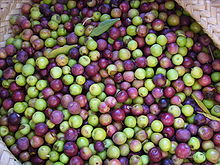Arbequina
| Arbequina | |
|---|---|
 Arbequina olives just after harvest | |
| Olive (Olea europaea) | |
| Origin | Spain |
| Use | Oil, table |
Arbequina is a cultivar of olives. The fruit is highly aromatic, small, symmetrical and dark brown, with a rounded apex and a broad peduncular cavity. In Europe, it is mostly grown in Catalonia, Spain,[1] but it is also grown in Aragon and Andalusia, as well as California, Argentina, Chile, and Australia. It has recently become one of the dominant olive cultivars in the world, largely under highly intensive, "super high-density" plantation.[2][3]
Etymology
The name comes from the village of Arbeca in the comarca of the Les Garrigues, where it was first introduced to Europe from Palestine in the seventeenth century by the Duke of Medinaceli.
Agronomic characteristics

Arbequina trees are adaptable to different conditions of climate and soil, although it does best in alkaline soils; it thrives in long, hot, dry summers, but is frost-hardy and pest-resistant. Its relatively small cup, allows it to be cultivated under more intense, high-density conditions than other plantation olives[4] The variety is very productive and enters early into production (from the first half of November). The fruit does not ripen simultaneously, and has an average resistance to detachment. Unlike most varieties, Arbequina has a high germination percentage, making it a common seedling tree for use as a rootstock. 78% of olive oil acres in California are planted on Arbequina rootstock.[5]
Gastronomy
Although sold as a table olive as well, Arbequina olives have one of the highest concentrations of oil, and are therefore mostly used for olive oil production.[6] Harvesting is easy since the trees are typically low to the ground and allow for easy hand picking. Oils made from Arbequina are generally buttery, fruity, and very mild in flavor,[7] being low in polyphenols.[3] The combination of low polyphenol levels and high levels of polyunsaturated fat as compared with other olive cultivars means that it has relatively low stability and short shelf-life.
See also
References
- ^ Shri Mohan Jain; P. M. Priyadarshan (1 January 2009), Breeding Plantation Tree Crops: Tropical Species, Springer, p. 433, ISBN 978-0-387-71201-7
- ^ Paul M. Vossen (1 January 2007), Organic Olive Production Manual, UCANR Publications, p. 9, ISBN 978-1-60107-440-9
- ^ a b Tom Mueller (5 December 2011), Extra Virginity: The Sublime and Scandalous World of Olive Oil, W. W. Norton, ISBN 978-0-393-08348-4
- ^ Ioannis Nikolaos Therios (January 2009), Olives, CABI, p. 122, ISBN 978-1-84593-620-4
- ^ Sturzenberger, Nicole (2009). Survey: Super-High-Density Olive Production in California (PDF). UC Olive Center. p. 3.
- ^ Stan Kailis; David Harris (1 February 2007), Producing Table Olives, Landlinks Press, pp. 69, 78, ISBN 978-0-643-09950-0
- ^ The Flavors of Olive Oil: A Tasting Guide and Cookbook, Simon & Schuster, 3 September 2002, pp. 4–5, ISBN 978-0-7432-1403-2
External links
Lua error in Module:Wd at line 2662: The function "Arbequina" does not exist.
